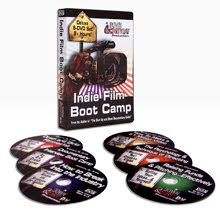A primary difference between pro and amateur shooters is that the pros know how to manually control their camera image and many amateurs simply let the camera decide how the shot should look and sound by relying heavily on the camera’s auto controls. The hectic and unpredictable nature of documentary shooting makes it tempting to just shoot everything in full auto mode.
The problem is that most of the auto functions on DV cameras are unreliable. Think of it as driving around the city with your car’s cruise control turned on… it’s great until you zip past a police car above the speed limit. The cruise control doesn’t know (or care) that you’re going to get a speeding ticket. It only works well in the most ideal setting… open road with no traffic lights or change in traffic or speed limit. The same is true with most camera auto functions. As soon as something outside of the ideal happens, they become much less reliable.
Your camera is not nearly as competent as you are. (Or will become by the end of your training.) Do not rely blindly on auto-focus or auto-sound levels or auto-iris. Take the time to learn and understand how to manually control the most important aspects of your video. The buttons and features will vary from camera to camera, but the principles of focus, exposure, and sound will always operate the same.
 Auto Zoom vs. Manual Zoom
Auto Zoom vs. Manual ZoomOne thing most DV cameras will do better than you is zoom. The servos (zoom motors) on most of the DV cameras made in recent years are pressure-sensitive and capable of very smooth and controlled moves. This is also practical because you will often have to zoom to adjust your frame and manually refocus at the same time.
Surprises and Panics
At some point in production a fleeting moment may come that you need to capture right that second. The president might walk into the room a few minutes earlier than expected. You may just be passing by and see that elusive C.E.O. slipping out of his office. The rare white leopard is about to pounce on his prey from a tree… whatever. Do whatever you gotta do to grab that image. Don’t waste time fussing with menu screens and white balancing. Just get the shot, man! Your sharp manual focus and perfect white balance mean nothing if the white leopard has already killed the antelope and made off with the carcass. In that case, you may as well be the antelope.
If you totally panic or have a brain fart in the moment, it’s okay. Just quickly switch the camera into auto-lock or full auto-mode. (That’s auto-everything.) You will most likely still get a pretty decent image and sound. It will be just like using a consumer camcorder. Better to go full auto and sacrifice some image and sound control than to have unusable footage because you forgot to adjust the sound level or re-white balance the camera. Don’t worry. Using manual controls will become second nature with practice. Just remember, getting the shot is numero uno.
Run and Gun Shooting
Run and gun shooting is when you are on-the-go and things are happening so quickly or under such confusion that there isn’t ample time or calm to concentrate on all the technic
 al details you need to consider. This includes situations such as covering unfolding violence like a riot or shooting in the crowd of a loud rowdy nightclub. Similarly, it may be wise to go with auto-functions when covering a short or sudden event where many visuals are happening all at once and you need to get full coverage before it all ends. Lastly, anytime you are shooting with unfamiliar equipment or all by yourself as director, cameraperson, sound recordist, and interviewer is an acceptable time to spread out some of those duties to the auto-functions.
al details you need to consider. This includes situations such as covering unfolding violence like a riot or shooting in the crowd of a loud rowdy nightclub. Similarly, it may be wise to go with auto-functions when covering a short or sudden event where many visuals are happening all at once and you need to get full coverage before it all ends. Lastly, anytime you are shooting with unfamiliar equipment or all by yourself as director, cameraperson, sound recordist, and interviewer is an acceptable time to spread out some of those duties to the auto-functions.Peep out the list below for a simple guide to help you figure out when auto-functions are most useful and when they are the video kiss of death...
AUTOFUNCTION DISFUNCTIONS:
AUTO FOCUS
Most Likely to Fail When:
• A person, car, or object crosses in front of your subject
• Lighting is low
• Objects are in the foreground (leaves, mic stand, crowd, etc.)
Most Useful When:
• You have an inexperienced operator on camera
• You are having difficulty seeing the viewfinder
• You are legally blind
AUTO-IRIS
Most Likely to Fail When:
• A bright object is in frame
• A scene is backlit
• There is snow on the ground
Most Useful When:
• You are shooting in a “run and gun” situation
• Lighting conditions change frequently or unpredictably.
AUTO GAIN CONTROL (AGC) SOUND
Most Likely to Fail When:
• An audience claps or laughs
• Naturally sharp/loud sounds (gunshot, subway, scream,etc.)
• There are silent gaps in sound
Most Useful When:
• The sound level does not fluctuate much
• You are solo in a “run and gun” situation
• You don’t have headphones












No comments:
Post a Comment